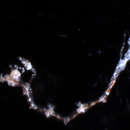en
names in breadcrumbs


Length: 13mm. Head with pair of anteriorly directed spines; pereonites 2 + 3 with pair of anteriorly directed spines medially and a strong anteriorly directed posterodorsal spine. Pereonites 6 + 7 fused. Antenna 1 longer than body, basal article of peduncle moderately swollen; antenna 2 as long as antenna 1 peduncle articles 1 + 2, flagellum biarticulate, without swimming setae. Propodus of gnathopod 1 triangular with single grasping spine, grasping margins of dactylus and propodus serrate. Gnathopod 2 attached anteriorly, propodus with proximal grasping spine and median poison tooth, palm moderately setose. Gills oval (not elongate). Pereopods 3 + 4 one-segmented. Pereopods 5 - 7 developed, six-segmented, moderately serrate, with pair of proximal grasping spines.
Tropical West-Pacific and Indian Oceans; west Australia
Caprellid, “Ghost” or “Skeleton” shrimps, so called for their skeletal appearance. Amphipod crustaceans, easily distinguished by the elongate stick-like body form and reduction of the abdominal appendages. Head is generally fused with pereonite 1. Pereopods on first 2 segments (pereonites) are most flexible and called gnathopods; gnathopods 2 being the largest, used in defense, feeding and substrate attachment. In many species pereopods 3 and 4 may also be reduced or absent. Gills on pereonites 3 + 4, rarely on pereonite 2. Pereopods 5 - 7 much smaller than 1 + 2, used for clinging to the substratum. In females, brood plates (öostegites) develop on pereonites 3 + 4. Much remains to be learnt about their biology, ecology and in many cases changing distributions.
18-28m. Shallow waters; sheltered; algae, seagrass, sponge, hydroids, gorgonians, soft corals, dead corals, bryozoans, ascidians, sediments and mangroves.